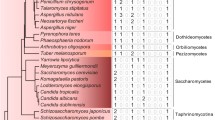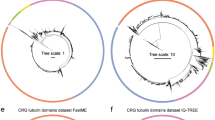Abstract
Sponges are one of the oldest metazoan phyla that are, due to their highly conservative nature, often referred to as the living fossils of multicellular animals. As such, they are a very important model for evolutionary, developmental and functional studies of Metazoa. Tubulin polymerization promoting proteins (TPPPs) are defined by the presence of p25-alpha domain (Pfam05517). Their functional characteristics resemble those of microtubule-associated proteins. Presence of TPPP homologous genes has been postulated in all eukaryotes with ciliated cells and their primary function has been proposed as some basic cilia-connected function. We present here the genomic structure and the corresponding cDNA sequence of one poriferan TPPP homolog (SdTPPP) isolated from the marine sponge Suberites domuncula; and a comparative analysis of TPPP homolog sequences and genomic structures from other Eukaryotes. Our results confirm the radiation of one TPPP homolog into three distinct genes in the Vertebrate lineage, but the origin of different sequences and their phylogenetic relationships show to be influenced by alternative protein isoforms, independent gene duplications, modularity of the p25-alpha domain and possible adaptational requirements to environmental conditions.
Similar content being viewed by others
Abbreviations
- EST:
-
expressed sequence tag
- MAP:
-
microtubule associated protein
- Myr:
-
million years
- NCBI:
-
National Center for Biotechnology Information
- TPPP:
-
tubulin polymerization promoting protein
- Plavi:
-
Plasmodium vivax
- Plafa:
-
Plasmodium falciparum
- Toxgo:
-
Toxoplasma gondii
- Tetth:
-
Tetrahymena thermophyla
- Parte:
-
Paramecium tetraurelia
- Leiin:
-
Leishmania infantum
- Trycr:
-
Trypanosoma cruzi
- Chlre:
-
Chlamydomonas reinhardtii
- Monbr:
-
Monosiga brevicollis
- Batde:
-
Batrachochytrium dendrobatidis
- Subdo:
-
Suberites domuncula
- Nemve:
-
Nematostella vectensis
- Strpu:
-
Strongylocentrotus purpuratus
- Ampqu:
-
Amphimedon queenslandica
- Hydma:
-
Hydra magnapapillata
- Cioin:
-
Ciona intestinalis
- Trica:
-
Tribolium castaneum
- Dromo:
-
Drosophila mojavensis
- Drowi:
-
Drosophila willistoni
- Drops:
-
Drosophila pseudoobscura
- Droya:
-
Drosophila yakuba
- Drome:
-
Drosophila melanogaster
- Nasvi:
-
Nasonia vitripennis
- Apime:
-
Apis mellifera
- Anoga:
-
Anopheles gambiae
- Aedae:
-
Aedes aegypti
- Culqu:
-
Culex quinquefasciatus
- Caeel:
-
Caenorhabditis elegans
- Bruma:
-
Brugia malayi
- Brafl:
-
Branchiostoma floridae
- Musmu:
-
Mus musculus
- Homsa:
-
Homo sapiens
- Tetni:
-
Tetraodon nigroviridis
- Osmmo:
-
Osmerus mordax
- Xenla:
-
Xenopus laevis
- Xentr:
-
Xenopus tropicalis
References
Altschul S.F., Madden T.L., Schäffer A.A., Zhang J., Zhang Z., Miller W. & Lipman D.J. 1997. Gapped BLAST and PSIBLAST: a new generation of protein database search programs. Nucleic Acids Res. 25: 3389–3402.
Aramini J.M., Rossi P., Shastry R., Nwosu C., Cunningham K., Xiao R., Liu J., Baran M.C., Rajan P.K., Acton T.B., Rost B. & Montelione G.T. 2007. Solution NMR structure of tubulin polymerization-promoting protein family member 3 from Homo sapiens. DOI:10.2210/pdb2jrf/pdb.
Ausubel F.M., Brent R., Kingston R.E., Moore D.D., Seidman J.G., Smith J.A., Struhl K. 2002. Current Protocols in Molecular Biology. John Wiley & Sons, New York.
Benson D.A., Karsch-Mizrachi I., Lipman D.J., Ostell J. & Sayers E.W. 2009. GenBank. Nucleic Acids Res. 37: D26–D31.
Bergquist P.R. 1978. Sponges. Hutchinson, London.
Boguski M.S., Lowe T.M. & Tolstoshev C.M. 1993. dbEST — database for “expressed sequence tags”. Nat. Genet. 4: 332–333.
Chalker D.L. & Stover N.A. 2007. Genome evolution: a double take for Paramecium. Curr. Biol. 17: R97–R99.
Chapman B.A., Bowers J.E., Feltus F.A. & Paterson A.H. 2006. Buffering of crucial functions by paleologous duplicated genes may contribute cyclicality to angiosperm genome duplication. Proc. Natl. Acad. Sci. USA 103: 2730–2735.
Gilbert W., de Souza S.J. & Long M., 1997. Origin of genes. Proc. Natl. Acad. Sci. USA 94: 7698–7703.
Hlavanda E., Klement E., Kókai E., Kovács J., Vincze O., Tőkési N., Orosz F., Medzihradszky K.F., Dombrádi V. & Ovádi J. 2007. Phosphorylation blocks the activity of tubulin polymerization promoting protein (TPPP): identification of sites targeted by different kinases. J. Biol. Chem. 282: 29531–29539.
Keeling P., Leander B.S. & Simpson A. 2009. Eukaryotes. Eukaryota, organisms with nucleated cells. Version 28 October 2009. http://tolweb.org/Eukaryotes/3/2009.10.28 in The Tree of Life Web Project.
Kleiger G. & Eisenberg D. 2002. GXXXG and GXXXA motifs stabilize FAD and NAD(P)-binding Rossmann folds through Cα-H…O hydrogen bonds and van der Waals interactions. J. Mol. Biol. 323: 69–76.
Kleinnijenhuis A.J., Hedegaard C., Lundvig D., Sundbye S., Issinger O.G., Jensen O.N. & Jensen P.H. 2008. Identification of multiple post-translational modifications in the porcine brain specific p25alpha. J. Neurochem. 106: 925–933.
Larkin M.A., Blackshields G., Brown N.P., Chenna R., McGettigan P.A., McWilliam H., Valentin F., Wallace I.M., Wilm A., Lopez R., Thompson J.D., Gibson T.J. & Higgins D.G. 2007. Clustal W and Clustal X version 2.0. Bioinformatics 23: 2947–2948.
Lehotzky A., Lau P., Tokési N., Muja N., Hudson L.D. & Ovádi J. 2010. Tubulin polymerization-promoting protein (TPPP/p25) is critical for oligodendrocyte differentiation. Glia 58: 157–168.
Li C.W., Chen J.Y. & Hua T.E. 1998. Precambrian sponges with cellular structures. Science 279: 879–882.
Marti M.J., Tolosa E. & Campdelacreu J. 2003. Clinical overview of the synucleinopathies. Mov. Disord. 18(Suppl 6): S21–S27.
Müller W.E.G. 1998. Origin of Metazoa: sponges as living fossils. Naturwissenschaften 85: 11–25.
Müller W.E.G. 2001. How was metazoan threshold crossed: the hypothetical Urmetazoa. Comp. Biochem. Physiol. A Mol. Integr. Physiol. 129: 433–460.
Nicholas K.B., Nicholas Jr. H.B. & Deerfield II D.W. 1997. Nicholas K.B., Nicholas Jr. H.B. & Deerfield II D.W. 1997. Gene-Doc: Analysis and Visualization of Genetic Variation. EMBNET News 4: 1–4.
Orosz F. 2009. Apicortin, a unique protein, with a putative cytoskeletal role, shared only by apicomplexan parasites and the placozoan Trichoplax adhaerens. Infect. Genet. Evol. 9: 1275–1286.
Orosz F., Kovács G.G., Lehotzky A., Oláh J., Vincze O. & Ovádi J. 2004. TPPP/p25: from unfolded protein to misfolding disease: prediction and experiments. Biol. Cell 96: 701–711.
Orosz F., Lehotzky A., Oláh J. & Ovádi J. 2009. TPPP/p25: A new unstructured protein hallmarking synucleinopathies, pp. 225–250. In: Ovádi J. & Orosz F. (eds) Protein Folding and Misfolding: Neurodegenerative Diseases (Focus on Structural Biology, Vol. 7), Springer, London, New York.
Orosz F. & Ovádi J. 2008. TPPP orthologs are ciliary proteins. FEBS Lett. 582: 3757–3764.
Otzen D.E., Lundvig D.M.S., Wimmer R., Nielsen L.H., Pedersen J.R. & Jensen P.H. 2005. p25 alpha is flexible but natively folded and binds tubulin with oligomeric stoichiometry. Protein Sci. 14: 1396–1409.
Ovádi J. & Orosz F. 2009. An unstructured protein with destructive potential: TPPP/p25 in neurodegeneration. BioEssays 31: 676–686.
Page R.D.M. 1996. TREEVIEW: an application to display phylogenetic trees on personal computers. Comp. Applic. Biosci. 12: 357–358.
Plese B., Grebenjuk V.A., Schröder H.C., Breter H.J., Müller I.M. & Müller W.E.G. 2008. Cloning and expression of a tauropine dehydrogenase from the marine sponge Suberites domuncula. Mar. Biol. 153: 1219–1232.
Rigby J.K., Budd G.E., Wood R.A. & Debrenne F. 1993. Porifera, pp. 71–99. In: Benton M.J. (ed.) The Fossil Record 2. Chapman & Hall, London.
Rogozin I.B., Sverdlov A.V., Babenko V.N. & Koonin E.V. 2005. Analysis of evolution of exon-intron structure of eukaryotic genes. Brief. Bioinform. 6: 118–34.
Rossmann M.G., Moras D. & Olsen K.W. 1974. Chemical and biological evolution of nucleotide-binding proteins. Nature 250: 194–195.
Rowland S.M. & Gangloff R.A. 1988. Structure and paleoecology of Lower Cambrian reefs. Palaios 3: 111–135.
Sayers E.W., Barrett T., Benson D.A., Bryant S.H., Canese K., Chetvernin V., Church D.M., DiCuccio M., Edgar R., Federhen S., Feolo M., Geer L.Y., Helmberg W., Kapustin Y., Landsman D., Lipman D.J., Madden T.L., Maglott D.R., Miller V., Mizrachi I., Ostell J., Pruitt K.D., Schuler G.D., Sequeira E., Sherry S.T., Shumway M., Sirotkin K., Souvorov A., Starchenko G., Tatusova T.A., Wagner L., Yaschenko E. & Ye J. 2009. Database resources of the National Center for Biotechnology Information. Nucleic Acids Res. 37: D5–D15.
Sbicego S., Nabholz C.E., Hauser R., Blum B. & Schneider A. 1998. In vivo import of unspliced tRNATyr containing synthetic introns of variable length into mitochondria of Leishmania tarentolae. Nucleic Acids Res. 26: 5251–5255.
Seack J., Perovic S., Gamulin V., Schröder H.C., Beutelmann P., Müller I.M. & Müller W.E.G. 2001. Identification of highly conserved genes: SNZ and SNO in the marine sponge Suberites domuncula: their gene structure and promoter activity in mammalian cells. Biochim. Biophys. Acta 1520: 21–34.
Song Y.J.C., Lundvig D.M.S., Huang Y., Gai W.P., Blumbergs P.C., Højrup P., Otzen D., Halliday G.M. & Jensen P.H. 2007. P25 alpha relocalizes in oligodendroglia from myelin to cytoplasmic inclusions in multiple system atrophy. Am. J. Pathol. 171: 1291–1303.
Štifanić M. & Batel R. 2007. Analysis of sponge genes indicates the short intron size. Periodicum Biologorum 109: 195–200.
Štifanić M., Mičić M., Ramšak A., Blašković S., Ruso A., Zahn R.K. & Batel R. 2009. p63 in Mytilus galloprovincialis and p53 family members in the phylum Mollusca. Comp. Biochem. Physiol. B Biochem. Mol. Biol. 154: 264–273.
Takahashi M., Tomizawa K., Ishiguro K., Sato K., Omori A., Sato S., Shiratsuchi A., Uchida T. & Imahori K. 1991. A novel brain-specific 25 kDa protein (p25) is phosphorylated by a Ser/Thr-Pro kinase (TPK II) from tau protein kinase fractions. FEBS Lett. 289: 37–43.
Venkatesh B., Ning Y. & Brenner S. 1999. Late changes in spliceosomal introns define clades in vertebrate evolution. Proc. Natl. Acad. Sci. USA 96: 10267–10271.
Vincze O., Tökési N., Oláh J., Hlavanda E., Zotter á., Horváth I., Lehotzky A., Tirián L., Medzihradszky K.F., Kovács J., Orosz F., & Ovádi J. 2006. Tubulin polymerization promoting proteins (TPPPs): members of a new family with distinct structures and functions. Biochemistry 45: 13818–13826.
Zhang Z., Wu C.C., Huang W.-N., Wang S., Zhao E., Huang Q., Xie Y. & Mao Y. 2002. A novel human gene whose product shares homology with bovine brain-specific protein p25 is expressed in fetal brain but not in adult brain. J. Hum. Genet. 47: 266–268.
Zhou W., Wang X., Li L., Feng X., Yang Z., Zhang W. & Hu R. 2010. Depletion of tubulin polymerization promoting protein family member 3 suppresses HeLa cell proliferation. Mol. Cell. Biochem. 333: 91–98.
Author information
Authors and Affiliations
Corresponding author
Rights and permissions
About this article
Cite this article
Štifanić, M., Batel, R. & Müller, W.E.G. Tubulin polymerization promoting protein (TPPP) ortholog from Suberites domuncula and comparative analysis of TPPP/p25 gene family. Biologia 66, 111–120 (2011). https://doi.org/10.2478/s11756-010-0147-y
Received:
Accepted:
Published:
Issue Date:
DOI: https://doi.org/10.2478/s11756-010-0147-y




